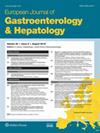调查 1990 年至 2019 年 70 岁以上老年人消化性溃疡疾病的流行负担:全球疾病负担研究分析。
IF 2.3
4区 医学
Q3 GASTROENTEROLOGY & HEPATOLOGY
European Journal of Gastroenterology & Hepatology
Pub Date : 2024-09-12
DOI:10.1097/meg.0000000000002847
引用次数: 0
摘要
背景消化性溃疡病(PUD)影响着全球年龄≥70岁的人群,对他们的健康和福祉产生了重大影响。本研究利用全球疾病负担研究(Global Burden of Disease Study)的数据,对 1990 年至 2019 年间 70 岁及以上人群中消化性溃疡病的患病率和时间变化进行了研究。分析包括评估估计年度百分比变化(EAPCs),以调查时间趋势和地区差异。结果在过去 30 年中,全球 70 岁及以上人群中患 PUD 的人数从 1990 年的 1 065 730 例增加到 2019 年的 1 608 463 例。尽管病例数量不断增加,但 PUD 在老年人中的流行率却呈现稳步下降趋势,在此期间的 EAPC 为-1.47(95% 置信区间:-1.57 至-1.37)。2019 年,70-74 岁、75-79 岁、80-84 岁和 85 岁及以上人群的 PUD 患病率分别为每 10 万人 313.36 例、365.77 例、388.45 例和 352.51 例。南亚、高收入北美和撒哈拉以南非洲中部是2019年PUD患病率最高的地区,分别为每10万人口624.90例、575.48例和474.80例。在国家层面,爱尔兰、澳大利亚、巴西、文莱达鲁萨兰国和孟加拉国有效地控制了PUD在老年人中的负担,实现了最大程度的减少。此外,社会经济发展水平较高的地区老年人的 PUD 负担往往相对较低,不同地区和不同年龄组的患病率也不尽相同。这项研究强调,亟需制定有针对性的公共卫生战略,以改善受 PUD 影响的老年人的治疗效果。本文章由计算机程序翻译,如有差异,请以英文原文为准。
Investigating the prevalence burden of peptic ulcer disease in older adults aged 70+ from 1990 to 2019: an analysis of Global Disease Burden Studies.
BACKGROUND
Peptic ulcer disease (PUD) affects individuals aged ≥70 years globally, exerting a significant impact on their health and well-being. Understanding its epidemiological evolution and associated factors is crucial for guiding interventions and improving management.
METHODS
This study utilized Global Burden of Disease Study data to examine the prevalence and temporal changes of PUD in individuals aged 70 years and older between 1990 and 2019. The analysis included assessing estimated annual percentage changes (EAPCs) to investigate temporal trends and regional variations.
RESULTS
Over the past 30 years, the number of individuals aged 70 years and above suffering from PUD globally has increased from 1 065 730 cases in 1990 to 1 608 463 cases in 2019. Despite an increasing number of cases, the prevalence of PUD among the elderly has exhibited a steady decline, with an EAPC of -1.47 (95% confidence interval: -1.57 to -1.37) over this timeframe. In 2019, the prevalence rates of PUD among individuals aged 70-74, 75-79, 80-84, and 85 years and older were 313.36, 365.77, 388.45, and 352.51 per 100 000 population, respectively. South Asia, high-income North America, and Central Sub-Saharan Africa were the regions with the highest prevalence rates of PUD in 2019, with rates of 624.90, 575.48, and 474.80 per 100 000 population, respectively. At the national level, Ireland, Australia, Brazil, Brunei Darussalam, and Bangladesh have effectively managed the burden of PUD among the elderly, achieving the greatest reduction. Additionally, regions with higher levels of socioeconomic development tended to have relatively lower burdens of PUD among the elderly, and prevalence rates varied across different regions and age groups.
CONCLUSION
Our study highlights the enduring burden of PUD among the global elderly population, emphasizing the significance of tailored interventions to address this pressing issue. This research underscores the critical need for targeted public health strategies aimed at improving outcomes specifically for older adults affected by PUD.
求助全文
通过发布文献求助,成功后即可免费获取论文全文。
去求助
来源期刊
CiteScore
4.40
自引率
4.80%
发文量
269
审稿时长
1 months
期刊介绍:
European Journal of Gastroenterology & Hepatology publishes papers reporting original clinical and scientific research which are of a high standard and which contribute to the advancement of knowledge in the field of gastroenterology and hepatology.
The journal publishes three types of manuscript: in-depth reviews (by invitation only), full papers and case reports. Manuscripts submitted to the journal will be accepted on the understanding that the author has not previously submitted the paper to another journal or had the material published elsewhere. Authors are asked to disclose any affiliations, including financial, consultant, or institutional associations, that might lead to bias or a conflict of interest.

 求助内容:
求助内容: 应助结果提醒方式:
应助结果提醒方式:


